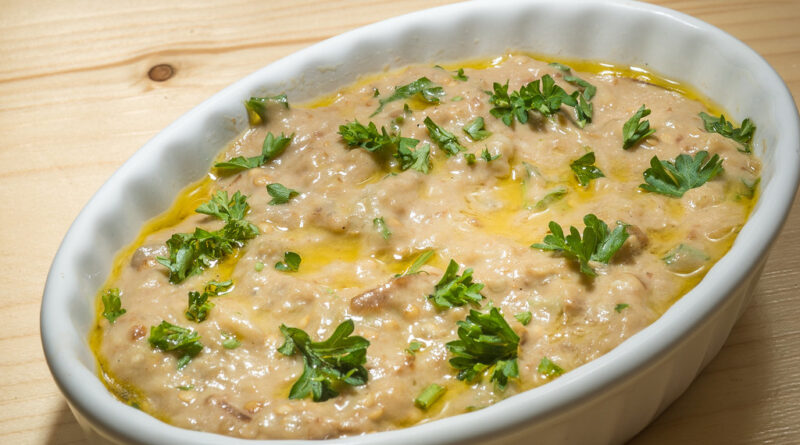Baba ganoush
Baba Ganoush: The Mediterranean Masterpiece
When it comes to the rich tapestry of Mediterranean cuisine, few dishes are as celebrated and cherished as Baba Ganoush. This creamy, smoky eggplant dip has transcended cultural boundaries and captured the hearts and taste buds of food enthusiasts around the world. In this culinary journey, we will delve into the history, ingredients, preparation, and cultural significance of Baba Ganoush, and explore why it has become a beloved Mediterranean masterpiece.
A Dip with Deep Roots
Baba Ganoush, also spelled “baba ghanoush” or “baba ghanouj,” has ancient origins deeply rooted in the Levant region of the Eastern Mediterranean. The term “Baba Ganoush” itself is Arabic, with “baba” roughly translating to “father” or “old man,” and “ganoush” signifying something pampered or beloved. In essence, it’s a term of endearment, hinting at the dish’s irresistible nature.
The Levant, which includes modern-day countries like Lebanon, Syria, Israel, and Palestine, has been the cradle of culinary innovation for centuries. It is here that Baba Ganoush was born, nurtured by the availability of abundant eggplants and a wealth of aromatic spices.
The Ingredients That Create Magic
At the heart of Baba Ganoush is the simplicity of its ingredients, which come together to create a harmonious flavor profile:
Eggplants (Aubergines)
Eggplants are the star of the show. The choice of eggplants can significantly affect the final flavor and texture of the dish. Traditional recipes often call for globe or Italian eggplants, which have a mildly sweet and smoky taste.
Tahini
Tahini is a creamy paste made from roasted sesame seeds. It provides a rich, nutty flavor and contributes to the luscious texture of Baba Ganoush. Tahini acts as a binding agent, bringing all the ingredients together.
Garlic
Garlic, whether minced or crushed, adds a pungent kick to the dip. The amount of garlic used can be adjusted to suit individual taste preferences, with some preferring a milder flavor and others reveling in the piquancy.
Lemon Juice
Freshly squeezed lemon juice provides a zesty, citrusy brightness that balances the richness of the tahini and the smokiness of the eggplants. It’s a crucial element in the flavor profile of Baba Ganoush.
Olive Oil
High-quality olive oil is essential for both flavor and presentation. It adds a fruity, savory note that ties the dish together. Additionally, a drizzle of olive oil on top of the finished Baba Ganoush is a common garnish.
Spices and Seasonings
Common seasonings include ground cumin, paprika, and salt. These spices enhance the overall flavor profile and add depth to the spread.
Garnishes
To garnish, fresh herbs like parsley or mint are often sprinkled on top of the Baba Ganoush. Not only do they provide a burst of color, but they also infuse the dish with an herbaceous aroma.
The Art of Crafting Baba Ganoush
While the flavors of Baba Ganoush are complex and deeply satisfying, its preparation is surprisingly straightforward. Here’s a step-by-step guide to crafting your own batch of silky-smooth Baba Ganoush:
Step 1: Roasting the Eggplants
- Begin by roasting the eggplants over an open flame, on a grill, or in the oven until their skins become charred and blistered. This step imparts a smoky flavor to the flesh.
- Allow the roasted eggplants to cool, then peel off the charred skin. This should be done gently to retain the smoky aroma.
Step 2: Draining Excess Moisture
- Place the peeled eggplants in a colander or sieve to drain excess moisture for about 15-20 minutes. This prevents the spread from becoming watery.
Step 3: Mashing and Mixing
- In a mixing bowl, mash the roasted eggplants using a fork or a potato masher until they reach a smooth consistency.
- Add minced garlic, tahini, lemon juice, and olive oil to the mashed eggplants.
- Season with ground cumin, paprika, and salt to taste.
- Stir and blend the ingredients until they are well combined.
Step 4: Garnish and Serve
- Transfer the Baba Ganoush to a serving dish.
- Drizzle extra olive oil over the top and garnish with fresh herbs, such as chopped parsley or mint.
- Serve the spread with warm pita bread, fresh vegetables, or as a dip for various Middle Eastern dishes.
The Cultural Significance of Baba Ganoush
Baba Ganoush is not just a culinary creation; it’s a cultural emblem that signifies warmth, hospitality, and the art of gathering. Its role in the Mediterranean dining experience extends beyond mere sustenance; it is a symbol of shared moments and cherished traditions.
A Mediterranean Staple
In the Mediterranean region, Baba Ganoush holds a hallowed place on the table. It is often served as part of a mezze platter, alongside other favorites like hummus, falafel, and tabbouleh. Its appearance at the beginning of a meal is a testament to the generosity and warmth of Middle Eastern hospitality, as it is frequently offered to guests with freshly baked bread.
An International Favorite
Baba Ganoush has transcended its regional origins and is now a favorite among those seeking the flavors of the Mediterranean. It can be found in Middle Eastern restaurants around the world, from the bustling streets of Beirut to the vibrant neighborhoods of New York City.
Regional Variations
While the classic recipe for Baba Ganoush remains beloved, variations of this dish can be found across the Middle East and beyond. These regional twists reflect the diverse culinary traditions of each area:
Moutabal (Lebanon)
In Lebanon, a variation known as “moutabal” is popular. Moutabal is often made with smoked eggplants, giving it a distinct smoky flavor. It is typically garnished with pomegranate seeds and served with flatbread.
Mutabbal (Egypt)
Egyptian mutabbal includes additional ingredients like yogurt and tahini. This variation is often spiced with ground coriander and cumin, creating a unique flavor profile.
Patlıcan Salatası (Turkey)
In Turkey, “patlıcan salatası” is similar to Baba Ganoush but may include the addition of chopped tomatoes, bell peppers, and red onions for added freshness and texture.
Salată de Vinete (Romania)
Romanian “salată de vinete” is a variation of Baba Ganoush that features eggplants, minced garlic, and mayonnaise. It is a popular spread enjoyed on bread or crackers.
Baba Ganoush Around the World
As Baba Ganoush continues to gain popularity globally, it is often served as an appetizer or dip on various occasions, including potlucks, picnics, and gatherings. It has also found its way into creative fusion cuisine, where chefs experiment with unique ingredients and presentation styles to make it their own.
The Pleasure of Baba Ganoush
What is it about Baba Ganoush that makes it such a beloved dish? It’s the combination of simplicity and depth of flavor. The smoky, earthy notes from the roasted eggplants, the nutty richness of tahini, the brightness of fresh lemon juice, and the warm embrace of garlic and spices all come together in perfect harmony.
Baba Ganoush is more than just a dip; it’s a sensory experience. It engages your taste buds with its complex flavors, transports you to the Mediterranean with its smoky aroma, and invites you to savor the moment with its creamy texture. It’s a reminder that the simplest ingredients, when prepared with care and love, can yield culinary masterpieces.
Conclusion
Baba Ganoush, with its centuries-old history and universal appeal, is a testament to the enduring power of food to connect people, bridge cultures, and evoke cherished memories. It reminds us that the joy of sharing a meal extends beyond the act of eating; it is about forging bonds, creating traditions, and celebrating life’s simple pleasures.
So, the next time you dip a piece of warm pita bread into a bowl of velvety Baba Ganoush, take a moment to savor not just the flavors but the rich tapestry of culture and history that this dish represents. It’s a journey to the heart of the Mediterranean, and it’s a journey worth savoring.



